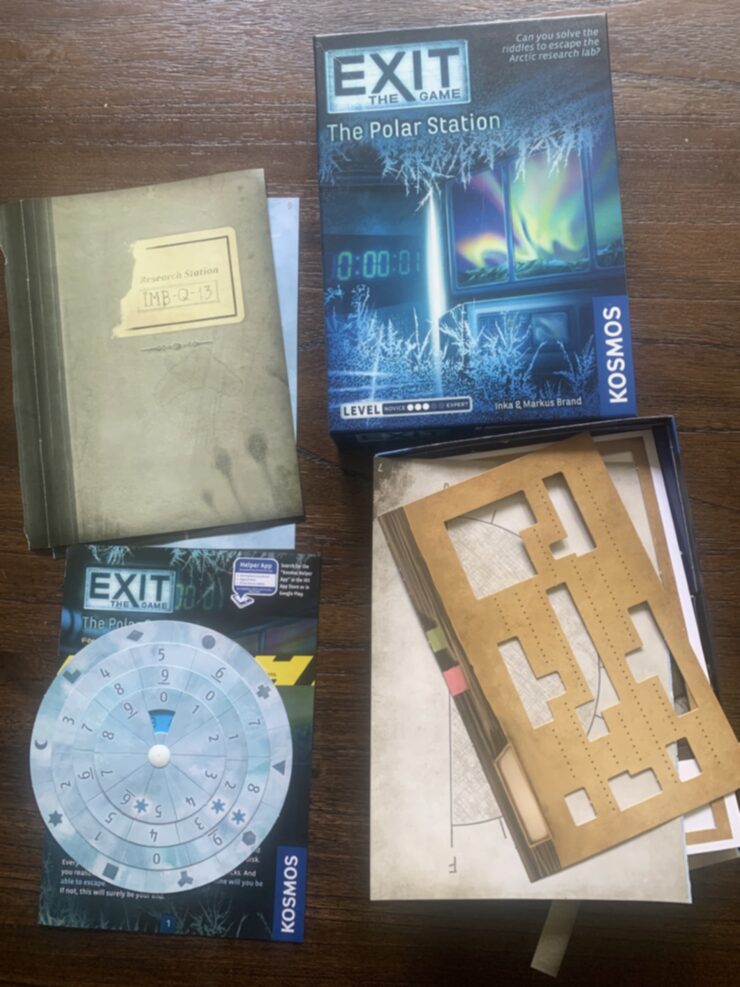Exit: The Game—The Polar Station
Maybe too much of a good thing
The Exit series are escape-rooms-in-a-box featuring riddles that must be completed under time pressure. Nothing prevents solo play, but, like an escape room, they are designed for a small group of friends who bring different ways of thinking. It’s also a single-play-only game since players will literally spoil the puzzles.

Reviewing such a game comes with unique challenges. Generally games need more than a single session to evaluate. Not only do some games unfold their secrets only after several plays, you gotta beware of letting an especially pleasant or disagreeable experience bias your conclusion. Puzzle games come with the added complication of the Goldilocks paradox of difficulty. Solutions that come too easily don’t satisfy and neither do puzzles that resist too much. Ideally your brain will be taxed just enough to be interesting without needing to read the help cards. Unfortunately every group will have a different level of just right and I can’t know where your level might be.
The Polar Station puts your team on a research station near the North Pole when something terrible happens. Fortunately help is coming. Unfortunately, you’ll need to open a series of containers in order to find the code that will open the door to exit. My daughter enjoyed the story at the start, but the focus shifts to puzzles pretty quickly. Each fits well into the overall theme, but there’s no time to read lore until the very end.
I played with my children: 10-year-old twins and my college-age son. We read the rules together and while the mechanism for opening each lock was quite involved, none of us had difficulty understanding it. Each lock opens when you enter the right combination of three digits into a ’90’s-style DRM code wheel, consult the card that matches the revealed number and cross-reference the object you are attempting to unlock to index a second card. Unlocking containers opens up more clue cards and sometimes a new component. It’s easier to manage than it sounds.
Without spoiling any of the riddles, you can immediately disassemble the booklet that’s included in the starting inventory. The game suggests a max of 4 players with the primary limitation being access to clues. Since the game starts with just the code wheel and the booklet, the first riddle involves clue congestion as everyone tries to examine the booklet at the same time. Even after getting more clues, the booklet remains the critical piece of most puzzles. You’re going to cut out pages by the end of the game, so why not spread out the material from the start?
Having the freedom to destroy components means the designers could stretch puzzles in unusual directions. It also means you can accidentally destroy a clue in the process of attempting to solve it. We ended up needing a solution for one riddle for that reason. (With a bit of tape I was able to see how the puzzle works after we’d finished our escape.) If we’d avoided our mistake, I suspect this riddle would have been a highlight. A little more instructional text might have prevented our mistake without harming the crux of the riddle.
After an hour, the younger half of our group wandered off. Around that point, the riddles tipped over into the frustrating category for us. Good puzzle game design gives players several puzzles to work on so that you can make progress on other problems while stuck an a particularly tricky problem. Some riddles need to marinate in the back of your mind for awhile. The Polar Station is surprisingly linear, however. I believe we maxed out at three simultaneously-open riddles and needed to check the solution of all three.
Taking help cards counts against the final score only if they provide new information. The first help card tells players which clues and components are used, but we didn’t normally need that help. We sometimes were helped by the second help card, but not enough to actually solve the riddles. As we neared the 2 hour mark, ego depletion kicked in, which meant we were in a particularly poor mental state to solve the riddles. Meanwhile, we’d also reached the hardest riddles in the game.
Thankfully the final few riddles were easier to solve and we escaped our polar prison. Whenever you finish, the story ends the same way. For people familiar with a particular cultural artifact, the narrative is wholly predictable, which is fine given the inventive riddles at the heart of the game. Since the game ended on riddles in our Goldilocks zone, we had a satisfying escape.
I only noticed after we finished that there is a helper app for this title that provides a tutorial and a timer with ambient sounds. The rule book said the app also includes three bonus riddles, but I don’t know where they might be.
Taken as a whole, The Polar Station comes together as a professionally developed experience for a bargain price. This is perhaps more difficult than the 3/5 level printed on the box implies. Again, this is group dependent and I haven’t tried any other entry in the series.